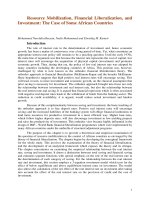The Principles of SCIENTIFIC MANAGEMENT 1910 doc
Bạn đang xem bản rút gọn của tài liệu. Xem và tải ngay bản đầy đủ của tài liệu tại đây (638.61 KB, 7 trang )
Under the old type of management success depends
*
almost entirely upon getting the “initiative” of the
workmen, and it is indeed a rare case in which this
initiative is really attained. Under scientific management
the “initiative” of the workmen (that is, their hard work, their good-will, and their ingenuity) is
obtained with absolute uniformity and to a greater extent than is possible under the old system; and in
addition to this improvement on the part of the men, the managers assume new burdens, new duties,
and responsibilities never dreamed of in the past. The managers assume, for instance, the burden of
gathering together all of the traditional knowledge which in the past has been possessed by the
workmen and then of classifying, tabulating, and reducing this knowledge to rules, laws, and formulæ
which are immensely helpful to the workmen in doing their daily work. In addition to developing a
science in this way, the management take on three other types of duties which involve new and heavy
burdens for themselves.
Library of Congress
Taylor, 1911
Frederick Winslow Taylor
The Principles of
SCIENTIFIC MANAGEMENT
1910
Ch. 2: “The Principles of Scientific Management”
excerpts
These new duties are grouped under four heads:
First. They develop a science for each element of a man’s work, which replaces the old rule-
of-thumb method.
Second. They scientifically select and then train, teach, and develop the workman, whereas in the
past he chose his own work and trained himself as best he could.
Third. They heartily cooperate with the men so as to insure all of the work being done in
accordance with the principles of the science which has been developed.
Fourth. There is an almost equal division of the work and the responsibility between the
management and the workmen. The management take over all work for which they are
better fitted than the workmen, while in the past almost all of the work and the greater
part of the responsibility were thrown upon the men.
*
Excerpted, and photographs added, by the National Humanities Center, Research Triangle Park, NC. 2005.
It is this combination of the initiative of the workmen, coupled with the new types of work done
by the management, that makes scientific management so much more efficient than the old plan. . . .
Perhaps the most prominent single element in modern scientific management is the task idea. The
work of every workman is fully planned out by the management at least one day in advance, and each
man receives in most cases complete written instructions, describing in detail the task which he is to
accomplish, as well as the means to be used in doing the work. And the work planned in advance in
this way constitutes a task which is to be solved, as explained above, not by the workman alone, but in
almost all cases by the joint effort of the workman and the management. This task specifies not only
what is to be done but how it is to be done and the exact time allowed for doing it. And whenever the
workman succeeds in doing his task right, and within the time limit specified, he receives an addition
of from 30 per cent. to 100 per cent. to his ordinary wages. These tasks are carefully planned, so that
both good and careful work are called for in their performance, but it should be distinctly understood
that in no case is the workman called upon to work at a pace which would be injurious to his health.
The task is always so regulated that the man who is well suited to his job will thrive while working at
this rate during a long term of years and grow happier and more prosperous, instead of being over-
worked. Scientific management consists very largely in preparing for and carrying out these tasks. . . .
One of the first pieces of work
undertaken by us, when the writer started
to introduce scientific management into
the Bethlehem Steel Company, was to
handle pig iron on task work. The
opening of the Spanish War found some
80,000 tons of pig iron placed in small
piles in an open field adjoining the
works. Prices for pig iron had been so
low that it could not be sold at a profit,
and it therefore had been stored. With the
opening of the Spanish War the price of pig iron rose, and this large accumulation of iron was sold.
This gave us a good opportunity to show the workmen, as well as the owners and managers of the
works, on a fairly large scale the advantages of task work over the old-fashioned day work and piece
work, in doing a very elementary class of work.
Natl. Canal Museum Archives
Bethlehem Steel, 1910
The Bethlehem Steel Company had five blast furnaces, the product of which had been handled by
a pig-iron gang for many years. This gang, at this time, consisted of about 75 men. They were good,
2
average pig-iron handlers, were under an excellent foreman who himself had been a pig-iron handler,
and the work was done, on the whole, about as fast and as cheaply as it was anywhere else at that time.
A railroad switch was run out into the field, right along the edge of the piles of pig iron. An
inclined plank was placed against the side of a car, and each man picked up from his pile a pig of iron
weighing about 92 pounds, walked up the inclined plank and dropped it on the end of the car.
We found that this gang were loading on the average about 12½ long tons per man per day. We
were surprised to find, after studying the matter, that a first-class pig-iron handler ought to handle
between 47
1
and 48 long tons per day, instead of 12½ tons. This task seemed to us so very large that
we were obliged to go over our work several times before we were absolutely sure that we were right.
Once we were sure, however, that 47 tons
was a proper day’s work for a first-class
pig-iron handler, the task which faced us
as managers under the modern scientific
plan was clearly before us. It was our
duty to see that the 80,000 tons of pig
iron was loaded on to the cars at the rate
of 47 tons per man per day, in place of
12½ tons, at which rate the work was
then being done. And it was further our
duty to see that this work was done
without bringing on a strike among the
men, without any quarrel with the men,
and to see that the men were happier and
better contented when loading at the new
rate of 47 tons than they were when loading at the old rate of 12½ tons.
Library of Congress
“Loading the pigs,” Pittsburgh, 1905
Our first step was the scientific selection of the workman. In dealing with workmen under this
type of management, it is an inflexible rule to talk to and deal with only one man at a time, since each
1
Many people have questioned the accuracy of the statement that first-class workmen can load 47½ tons of pig iron from the ground on to
a car in a day. For those who are skeptical, therefore, the following data relating to this work are given:
First. That our experiments indicated the existence of the following law: that a first-class laborer, suited to such work as handling pig iron,
could be under load only 42 per cent. of the day and must be free from load 58 per cent. of the day.
Second. That a man in loading pig iron from piles placed on the ground in an open field on to a car which stood on a track adjoining
these piles, ought to handle (and that they did handle regularly) 47½ long tons (2240 pounds per ton) per day. . . .
A pig-iron handler walks on the level at the rate of one foot in 0.006 minutes. The average distance of the piles of pig iron from the car
was 36 feet. It is a fact, however, that many of the pig-iron handlers ran with their pig as soon as they reached the inclined plank. Many of
them also would run down the plank after loading the car. So that when the actual loading went on, many of them moved at a faster rate
than is indicated by the above figures. . . .
If any one who is interested in these figures will multiply them and divide them, one into the other, in various ways, he will find that all
of the facts stated check up exactly. [Footnote in original]
3
workman has his own special abilities and limitations, and since we are not dealing with men in
masses, but are trying to develop each individual man to his highest state of efficiency and prosperity.
Our first step was to find the proper workman to begin with. We therefore carefully watched and
studied these 75 men for three or four days, at the end of which time we had picked out four men who
appeared to be physically able to handle pig iron at the rate of 47 tons per day. A careful study was
then made of each of these men. We looked up their history as far back as practicable and thorough
inquiries were made as to the character, habits, and the ambition of each of them. Finally we selected
one from among the four as the most likely man to start with. He was a little Pennsylvania Dutchman
who had been observed to trot back home for a mile or so after his work in the evening about as fresh
as he was when he came trotting down to work in the morning. We found that upon wages of $1.15 a
day he had succeeded in buying a small plot of ground, and that he was engaged in putting up the walls
of a little house for himself in the morning before starting to work and at night after leaving. He also
had the reputation of being exceedingly “close,” that is, of
placing a very high value on a dollar. As one man whom we
talked to about him said, “A penny looks about the size of a cart-
wheel to him.” This man we will call Schmidt.
The task before us, then, narrowed itself down to getting
Schmidt to handle 47 tons of pig iron per day and making him
glad to do it. This was done as follows. Schmidt was called out
from among the gang of pig-iron handlers and talked to
somewhat in this way:
“Schmidt, are you a high-priced man?”
“Vell, I don’t know vat you mean.”
“Oh yes, you do. What I want to know is whether you are a
high-priced man or not.”
“Vell, I don’t know vat you mean.”
“Oh, come now, you answer my questions. What I want to
find out is whether you are a high-priced man or one of these
cheap fellows here. What I want to find out is whether you want
to earn $1.85 a day or whether you are satisfied with $1.15, just the same as all those cheap fellows are
getting.”
Natl. Canal Museum Archives
Henry Noll, “went from hauling 13 tons
of pig iron a day to 48 tons during an
incentive program run by efficienc
y
expert Frederick Taylor,” n.d.
“Did I vant $1.85 a day? Vas dot a high-priced man? Vell, yes, I vas a high-priced man.”
4
“Oh, you’re aggravating me. Of course you want $1.85 a day every one wants it! You know
perfectly well that that has very little to do with your being a high-priced man. For goodness’ sake
answer my questions, and don’t waste any more of my time. Now come over here. You see that pile of
pig iron?”
“Yes.”
“You see that car?”
“Yes.”
“Well, if you are a high-priced man,
you will load that pig iron on that car to-
morrow for $1.85. Now do wake up and
answer my question. Tell me whether you
are a high-priced man or not.”
“Vell did I got $1.85 for loading
dot pig iron on dot car to-morrow?”
“Yes, of course you do, and you get
$1.85 for loading a pile like that every
day right through the year. That is what a
high-priced man does, and you know it
just as well as I do.”
“Vell, dot's all right. I could load dot
pig iron on the car to-morrow for $1.85, and I get it every day, don’t I?”
Library of Congress
Cords of pig iron, Pittsburgh, 1905
“Certainly you do certainly you do.”
“Vell, den, I vas a high-priced man.”
“Now, hold on, hold on. You know just as well as I do that a high-priced man has to do exactly as
he’s told from morning till night. You have seen this man here before, haven’t you?”
“No, I never saw him.”
“Well, if you are a high-priced man, you will do exactly as this man tells you to-morrow, from
morning till night. When he tells you to pick up a pig and walk, you pick it up and you walk, and when
he tells you to sit down and rest, you sit down. You do that right straight through the day. And what’s
more, no back talk. Now a high-priced man does just what he’s told to do, and no back talk. Do you
understand that? When this man tells you to walk, you walk; when he tells you to sit down, you sit
down, and you don’t talk back at him. Now you come on to work here to-morrow morning and I’ll
know before night whether you are really a high-priced man or not.”
5
This seems to be rather rough talk. And indeed it would be if applied to an educated mechanic, or
even an intelligent laborer. With a man of the mentally sluggish type of Schmidt it is appropriate and
not unkind, since it is effective in fixing his attention on the high wages which he wants and away from
what, if it were called to his attention, he probably would consider impossibly hard work. . . .
Schmidt started to work, and all day long, and at regular intervals, was told by the man who stood
over him with a watch, “Now pick up a pig and walk. Now sit down and rest. Now walk now rest,”
etc. He worked when he was told to work, and rested when he was told to rest, and at half-past five in
the afternoon had his 47½ tons loaded on the car. And he practically never failed to work at this pace
and do the task that was set him during the three years that the writer was at Bethlehem. And
throughout this time he averaged a little more than $1.85 per day, whereas before he had never
received over $1.15 per day, which was the ruling rate of wages at that time in Bethlehem. That is, he
received 60 per cent higher wages than were paid to other men who were not working on task work.
One man after another was picked out and trained to handle pig iron at the rate of 47½ tons per day
until all of the pig iron was handled at this rate, and the men were receiving 60 per cent more wages
than other workmen around them. . . .
Doubtless some of those who are especially interested in working men will complain because
under scientific management the workman, when he is shown how to do twice as much work as he
formerly did, is not paid twice his former wages, while others who are more interested in the dividends
than the workmen will complain that under this system the men receive much higher wages than they
did before.
It does seem grossly unjust when the bare statement is made that the competent pig-iron handler,
for instance, who has been so trained that he piles 3 6/10 times as much iron as the incompetent man
formerly did, should receive an increase of only 60 per cent. in wages.
It is not fair, however, to form any final judgment until all of the elements in the case have been
considered. At the first glance we see only two parties to the transaction, the workmen and their
employers. We overlook the third great party, the whole people, the consumers, who buy the
product of the first two and who ultimately pay both the wages of the workmen and the profits of the
employers.
The rights of the people are therefore greater than those of either employer or employé. And this
third great party should be given its proper share of any gain. In fact, a glance at industrial history
shows that in the end the whole people receive the greater part of the benefit coming from industrial
improvements. In the past hundred years, for example, the greatest factor tending toward increasing the
output, and thereby the prosperity of the civilized world, has been the introduction of machinery to
6
replace hand labor. And without doubt the greatest gain through this change has come to the whole
people the consumer. . . .
It is no single element, but rather this whole combination, that constitutes scientific management,
which may be summarized as:
Science, not rule of thumb.
Harmony, not discord.
Cooperation, not individualism.
Maximum output, in place of restricted output.
The development of each man to his greatest efficiency and prosperity.
The writer wishes to again state that: “The time is fast going by for the great personal or
individual achievement of any one man standing alone and without the help of those around him. And
the time is coming when all great things will be done by that type of cooperation in which each man
performs the function for which he is best suited, each man preserves his own individuality and is
supreme in his particular function, and each man at the same time loses none of his originality and
proper personal initiative, and yet is controlled by and must work harmoniously with many other men.”
7









